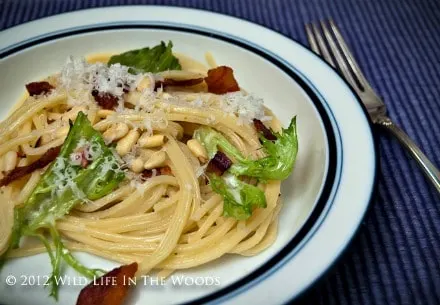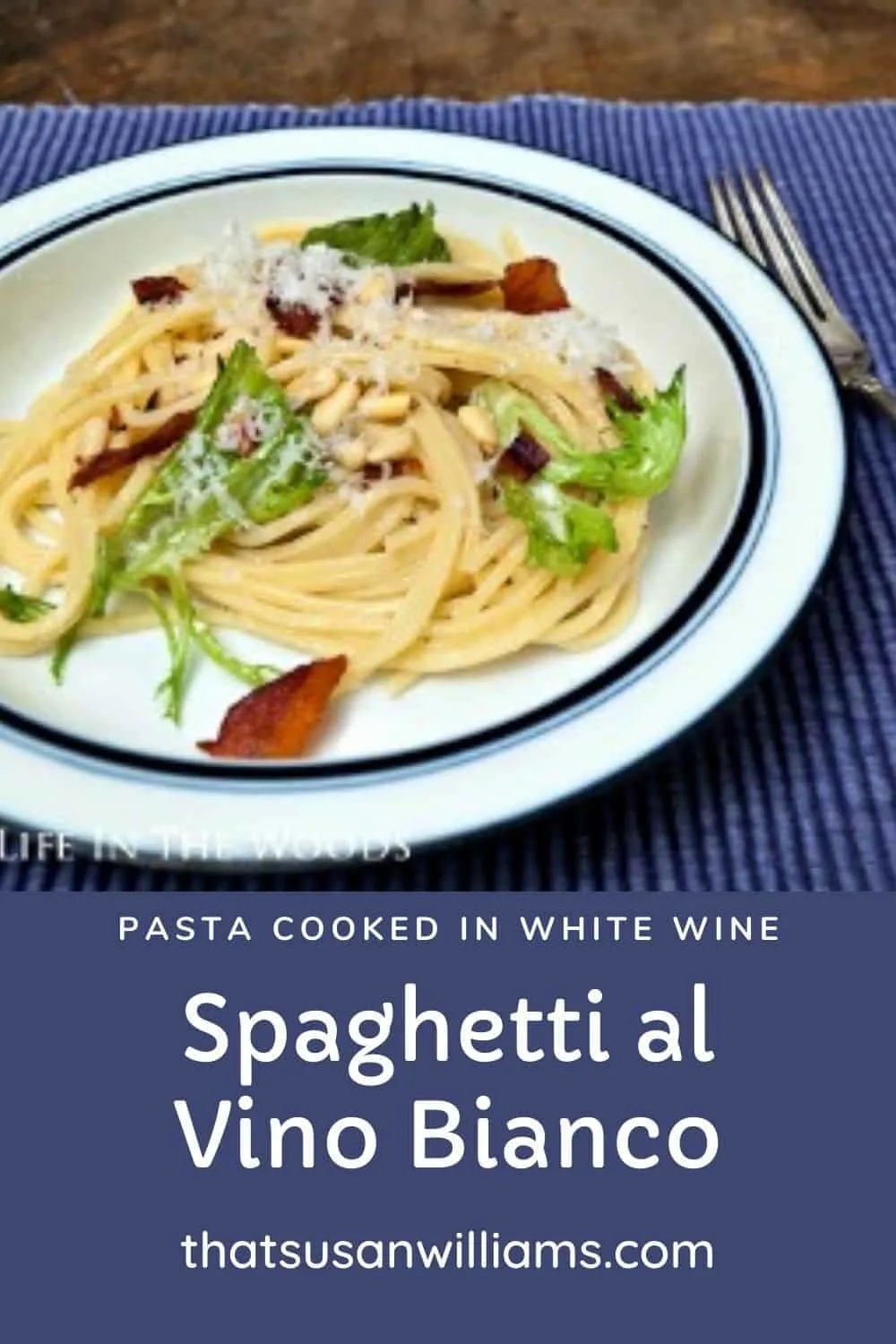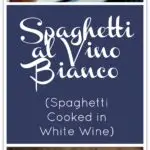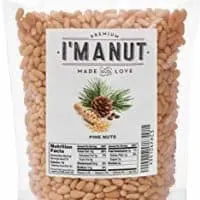This post contains links that, if you click on them and make a purchase, will earn me money. As an Amazon Associate, I earn from qualifying purchases. . Regardless, I only recommend products or services that I believe will be good for my readers. Thanks for helping me continue to produce great content!

Spaghetti al Vino Bianco is a delicious recipe for pasta, where the pasta makes its own sauce by being finished in white wine.
I’ve been wanting to try a recipe similar to this, written by Mario Batali. Batali had shared a recipe where he cooked pasta in red wine. This sounded completely intriguing to me, but when I read some reviews that said the pasta turned an unappealing dull purple hue, I decided I’d hold off trying his recipe.
Then, I ran into this recipe by Cooks Illustrated, that uses white wine. I was eager to try it, since I figured that would solve the “purple” problem.
Do You Really Cook the Pasta in Wine?
“Pasta cooked in wine” is a bit deceptive: it actually only finishes cooking in wine. Most of its cooking occurs in the usual large pot of boiling, salted water.
What Does Reducing the Wine Mean?
While the pasta is cooking in that big pot of water, you intensify the flavor of the wine by reducing it. That simply means bringing it to a boil to allow the alcohol and some of the water to cook out of it, thus causing the flavor of the wine to be more concentrated.
You then add even more flavor to the dish by introducing some aromatics, like garlic and red pepper flakes. The slightly undercooked pasta gets added to the wine reduction, where it absorbs all that delicious wine flavor you’ve developed. Following that, you finish the sauce with cream and grated Pecorino Romano.
Next, briefly steam a delicate green on top of the pasta. And finally, you add texture, color and flavor by sprinkling your plate of sauced pasta and greens with crispy pancetta or bacon, and toasted pine nuts.
So that’s the general idea, and the finished product is so good!
SO good!!!
(Although, I admit, it was much more to MY taste, than to my husband’s taste. He liked it, but didn’t LOVE it.)
Notes for Changes/Adaptations I Made:
First, in regard to less common ingredients: the recipe called for pancetta, and the one I used came from Whole Foods, pre-sliced and pre-packaged. It was wonderful! I would definitely use it again. Bacon would be a great substitute if you don’t have easy access to pancetta. However, I really enjoyed the unique peppery flavor of the pancetta.
Second: The recipe also called for Pecorino Romano, which I happened to have on hand. If you don’t have any, you could substitute Parmesan, which has a nuttier flavor. I’d actually be interested in trying this recipe next time with Parmesan instead. (Pecorino Romano is made from sheep’s milk, and is much more pungent.)
Third: I didn’t have any arugula, which is what the original recipe called for. But I did have a delicate artisanal lettuce that I purchased from Costco called Petite Tango, that looked a bit like frisée. It worked great! These days, I tend to keep arugula on hand a lot more, so I’ll try it next time with arugula.
Fourth: (and in regard to the wine I chose): The wine I used was a Picpoul de Pinet. Cooks Illustrated recommends a good-quality dry white wine, but to avoid a Chardonnay that is heavy on oaked flavor.
The Picpoul de Pinet was dry, with just a hint of sweetness, delicious to sip all on its own. But if I’d make one change to the finished recipe, I’d add about a teaspoon more of sugar to the sauce. Cooks Illustrated mentioned that if the sauce’s taste was too sharp, the cook should add up to a tablespoonful of sugar, one teaspoon at a time, according to taste. I added one teaspoon of sugar, which helped the flavor immensely, considering the tartness of the flavor that the wine I had chosen had produced. I was afraid to add too much, and so I think I erred on the side of too much caution. Next time, I’ll probably try a Sauvignon Blanc.

Please pin this on Pinterest or share it on Facebook!
Now, on to my adaptation of Cooks Illustrated recipe for:
Spaghetti al Vino Bianco
Spaghetti al Vino Bianco: Spaghetti Cooked in White Wine

A delicious recipe for pasta, that basically makes its own sauce as it finishes cooking in reduced white wine.
Ingredients
- 1 T. extra virgin olive oil
- 4 oz. pancetta, cut into 1/4″ pieces
- 2 garlic cloves, minced
- pinch red pepper flakes
- 1 bottle dry white wine (750 ml)
- salt and freshly ground black pepper
- sugar (up to 1T. added 1 teaspoonful at a time, if needed)
- 1 lb. spaghetti
- one small head of Petite Tango lettuce or 1 c. arugula
- 1/3 c. cream
- 1/2 c. grated Pecorino Romano, plus more for serving
- 1/4 c. toasted pine nuts
Instructions
- Heat oil and pancetta in a 12″ skillet over medium-high heat; cook until pancetta is browned and crisp, approximately 3-5 minutes. Transfer to paper towels to drain. Pour off and discard all but 2 T. fat from skillet.
- Return skillet to medium-low heat and add minced garlic and pepper flakes. Stir till garlic is fragrant, about 30 seconds – 1 minute. Carefully add 1 1/2 c. wine and increase heat to medium-high. Cook until wine is reduced to 1/2 c., 8-10 minutes. Add 1/2 t. salt. Taste and season with up to 1 tablespoon of sugar, tasting after you add each teaspoon to see if more is necessary.
- Bring 4 q. water to a boil in a large pot. Add pasta and 1 T. salt and cook, stirring often, until pasta is flexible, but NOT fully cooked, about 4 minutes. Reserve 2 c. of pasta water in a measuring cup, then drain pasta.
- Transfer pasta to skillet with reduced white wine. Place skillet over medium heat; add 1/2 cup unreduced wine and cook, tossing constantly until wine is fully absorbed. Continue to add remaining wine, 1/2 c. at a time, tossing constantly, until pasta is al dente, about 8 minutes. Add any of the reserved pasta water necessary to keep the sauce as loose as you’d like, or if pasta is still uncooked, but all wine has been absorbed.)
- Remove skillet from heat. Place lettuce/arugula on top of spaghetti; pour 1/4 c. reserved pasta water over lettuce, cover, and let stand for 1 minute. Add cream and 1/4 c. Pecorino Romano; toss until sauce lightly coats pasta and lettuce is evenly distributed. Season with salt and pepper to taste.
- Transfer to serving platter and sprinkle with pancetta, remaining 1/4 c. Pecorino Romano, and pine nuts. Serve immediately, passing extra Pecorino Romano separately.
Recommended Products
As an Amazon Associate and member of other affiliate programs, I earn from qualifying purchases.
Nutrition Information:
Yield:
4Serving Size:
1Amount Per Serving: Calories: 674Total Fat: 35gSaturated Fat: 13gTrans Fat: 0gUnsaturated Fat: 19gCholesterol: 53mgSodium: 250mgCarbohydrates: 44gFiber: 2gSugar: 5gProtein: 14g
Have you ever tried cooking pasta in wine?






Julie Jaskowiak
Monday 4th of June 2018
I made this. We all thought it was delicious!
Mauricio
Wednesday 13th of May 2015
Susan, thank you for the recipe but even more for sharing the spirit of the recipe. That is what makes it special.